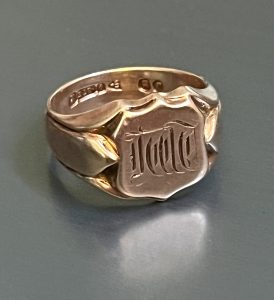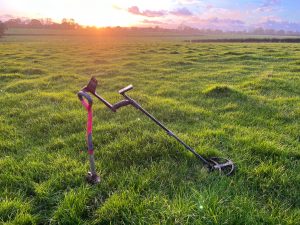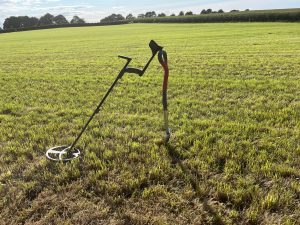
It was a chilly February morning when I set off for one of my favourite permissions. At it’s centre is the site of a medieval moated manor house, all that is left of it now is part of the moat. Where the house once stood is now just a paddock. The house was known to have been there in the 12th Century, but seems to have disappeared sometime in the 18th Century. Old maps show what was once an orchard and gardens surrounding the site of the house, but today they are just a collection of fields. A new house was built a few hundred metres away sometime in the late 18th Century.
Today I was going to finish off a very small paddock that I know was once part of the orchard and then move into the neighbouring larger meadow.
I started in the small paddock and covered the only part I hadn’t yet done. I wasn’t finding much, just the usual scraps of lead and fragments of unidentifiable waste metal. I then found a pre decimalk copper penny, then tucked away close to the fence I found a nice sounding signal and carefully dug out a small round section of grass and checked the hole with my detector, it was still in there so it was now time to get down on my hands and knees with the pinpointer, to work out wherever this item was in the hole. I soon located it, it seemed to be another inch or so down, so I gently prised the compacted soil away using the tip of my digging tool, trying to break the soil a little way from the find to avoid damaging it.
I soon found a small metal loop shaped item, but I knew what it was straight away from the shape and style. It was a medieval purse bar.

Purse bars do get found quite regularly, this one dates from the 15th Century and could have been dropped by a trader as he passed through the area.
But what is a purse bar?
A purse bar is basically the metal loop and handle that form the top of a purse. A leather bag would have hung from this in which the owner would keep their money. The loop allowed it to be hung up on something, or attached to a belt. The leather bag of course, would have long decayed and disappeared, but what about the coins that were once inside it?
Well of course there might not have been any, it could have been empty when it was lost or discarded, but if you ever do find a medieval purse bar when you are out detecting make sure that you search the area very carefully, in case their is a spill of medieval coins somewhere nearby. Sadly, I found no trace of any coins near the spot where I found the purse bar.
I then decided to move into the meadow next door, this is a large space, somewhere in the region of 25 acres and on its own would take many years to search throughly.

I decided just to generally roam about to see if i could find any hot spots. hot spots are just an area where you find something worthwhile then you can focus more closely on that area to see if there is anything else.
To be honest I didn’t find much, a few more pre decimal copper coins and more scraps of lead and small offcuts of copper. I did find part of a broken bell, but I have no idea how old it might have been. I then worked my way back towards the first tiny paddock, find the odd button and relatively modern coins along with a few pigeon rings.
Then I found a nice steady high, but soft tome with a reading in the high 80’s on my detectors display screen. Again I carefully dug a plug of soil out, and once more after checking with my detector, it was still in the hole.
My pinpointer soon found it and I carefully using my fingers prised out a clump of soil, the find was inside, so I started to carefully break it apart, then it was free, it was dirty of course, but I could see that it was shiny and silvery and quite thin. It was a hammered silver coin, I love finding these, they always make my heart beat a little faster as I gently clean it off. I could make out a date on it, but the bust side was almost worn smooth. The date was 1569, it was a Queen Elizabeth I silver hammered groat. A groat is a four pence coin. It was probably lost some time in the 1600’s and I was the first person to hold it in maybe 400 years.
I was in sight of my car by now, so decided to carefully search the area in case there were more, could it have come from the lost leather purse bar I found earlier? Unfortunately after spending a good hour carefully searching the area I found nothing more, so I then decided to call it a day and headed home.
Once I was home, I carefully cleaned and photographed my finds. The following weekend, I returned to the farm and knocked on the door. I stood chatting to the farmer and his wife for 10 minutes or so and showed them the silver groat and the purse bar. They carefully looked at them, then handed them back. I told them to keep the groat as it was something of interest found on their land. Since then they let me detect anywhere on their land and I can come and go as I please. So it is always worth showing your landowners your finds and making sure that they keep some things themselves.





